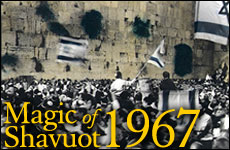 Identifying as a Jew
Identifying as a Jew


4 min read
200,000 Jews converged on the Western Wall that day.
Over the last two millennia, Jews have visited Jerusalem in honor of the festivals, in lieu of the biblically-ordained pilgrimages. On the holiday of Shavuot, there was also the custom to visit the purported grave of King David on Mount Zion, since the date of his death was on Shavuot.
When Shavuot arrived in 1948, it was a month after the establishment of the State of Israel, and Jews could no longer continue to make the pilgrimage to the Western Wall. The Jordanians, who occupied the eastern half of the city since the War of Independence, blocked all rights of passage to the Jews. However, the pilgrimage to King David's tomb on nearby Mount Zion, located on the Israeli side of divided Jerusalem, continued. Over the next 19 years, crowds made their way to Mount Zion, where across barbed wire they could view the Old City and the Temple Mount.
On the morning of Shavuot, June 15, 1967 – just six days after the liberation of the Old City of Jerusalem in the Six Day War – the Old City was officially opened to the Israeli public. (The army wanted to be sure there were no landmines or snipers still in the Old City.) For the first time in almost 2,000 years, masses of Jews could visit the Western Wall and walk through the cherished streets of Judaism's capital city as members of the sovereign Jewish nation. Each Jew who ventured to the Western Wall on that unforgettable day was realizing their ancestors' dreams over the millennia. It was one of those rare, euphoric moments in history.
From the late hours of the night, thousands of Jerusalem residents streamed toward the Zion gate, eagerly awaiting entry into the Old City. At 4 a.m., the accumulating crowds were finally allowed to enter the area of the Western Wall. As the sun continued to rise, there was a steady flow of thousands who made their way to the Old City.
The Jerusalem Post described the epic scene:
Every section of the population was represented. Kibbutz members and soldiers rubbing shoulders with Neturei Karta. Mothers came with children in prams, and old men trudged steeply up Mount Zion, supported by youngsters on either side, to see the wall of the Temple before the end of their days.
Some wept, but most faces were wreathed in smiles. For 13 continuous hours, a colorful variety of all peoples trudged along in perfect order, stepping patiently when told to do so at each of six successive barriers set up by the police to regulate the flow.
In total, 200,000 visited the Western Wall that day. It was the first pilgrimage, en masse, of Jews to Jewish-controlled Jerusalem on a Jewish festival in 2,000 years, since the pilgrimages for the festivals in Temple times.
An eyewitness described the moment:
"I've never known so electric an atmosphere before or since. Wherever we stopped, we began to dance. Holding aloft Torah scrolls we swayed and danced and sang at the tops of our voices. So many of the Psalms and songs are about Jerusalem and Zion, and the words reached into us a new life. As the sky lightened, we reached the Zion gate. Still singing and dancing, we poured into the narrow alleyways beyond."
On Shavuot, 3,279 years earlier, the Israelites stood at Mount Sinai and forged a relationship with their Creator. On the day of Shavuot following Israel's amazing victory in the Six Day War, multitudes ascended to the Western Wall, and they, too, felt the eternal magic of this moment. After all, "For from Zion shall come forth Torah, and the Word of God from Jerusalem."
This "pedestrian pilgrimage" has now become a recurring tradition. And on this year as well, early on Shavuot morning – after a full night of Torah learning – the streets of Jerusalem will be filled with tens of thousands of Jews, walking with and anticipation and awe to the Western Wall.
